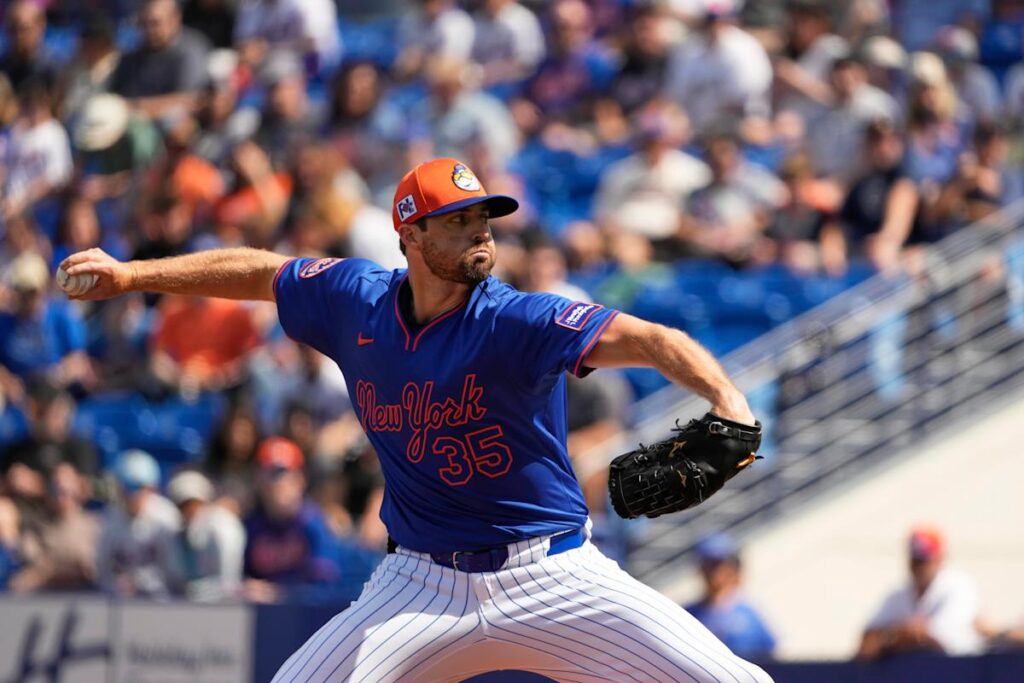PORT ST. LUCIE, Fla. — Mets owner Steve Cohen, honest to a fault, admitted that he’d heard the doubts.
On a recent tranquil morning at Mets spring training, the richest man in human history to ever wear a hat with a sunglasses-wearing-cartoon-baseball-person logo held court with members of the media. The question-and-answer session touched on all corners of the organization, as the unmistakable wave of optimism permeating the camp took focus via Cohen’s comments. Two days prior, Juan Soto, the $765 million man, had arrived for his first day of work. Understandably, most everybody in the Mets’ extended universe was in a good mood.
But when asked for a 10,000-foot view of the club, Cohen at least acknowledged one area of concern: the public perception that his Mets don’t have a World Series-caliber pitching staff.
“I think our pitching is going to surprise people,” the bespectacled billionaire declared, “even though there’s a lot of talk about our starting pitching.”
[Join or create a Yahoo Fantasy Baseball league for the 2025 MLB season]
That statement, in and of itself, was recognition that the baseball industry writ large has serious doubts about New York’s starting rotation. And on Monday, those whispers grew louder with the news that Sean Manaea, New York’s best pitcher last season, is likely to miss the beginning of the regular season due to an oblique strain. Manaea won’t throw for two to three weeks. The likeable left-hander, who re-signed with the Mets over the winter, was the front-runner to start on Opening Day.
It’s the Mets’ second starting pitching injury of camp. The team will also be without free-agent addition Frankie Montas until at least late May after the right-handed starter suffered a high-grade lat strain earlier this spring.
But even before Manaea and Montas hit the shelf, New York’s staff was shaping up to be a potential Achilles’ heel for a team with championship aspirations.
Last season, pitching was indeed the downfall for a Cinderella Mets team that stormed its way to the NLCS. In that deciding series against the Dodgers, the Mets surrendered an average of 10 runs in their four losses to the eventual World Series champs. Manaea, clearly exhausted, got shelled in the Game 6 clincher. Everybody knew the Mets needed more arms.
And so it was compelling when, in the offseason, Cohen and president of baseball operations David Stearns opted to add depth over impact. The Mets and their deep pockets never seriously engaged at the top of the market for arms such as Max Fried, Corbin Burnes and Blake Snell.
Instead, they sought out lower-budget hurlers with warts and developmental upside. Montas (2 years, $37 million) had a 4.84 ERA last season, while Griffin Canning (1 year, $4 million) led the league in home runs allowed. Clay Holmes (3 years, $38 million) was a phenomenal closer for the Yankees, but the Mets’ plan to convert him to the rotation carries risk. Even Manaea (3 years, $75 million), who looked like a frontline force after lowering his arm slot midseason, has just a few months of recent elite performance.
But a few raised eyebrows from the fan base didn’t stop Stearns, regarded as one of the best executives in the game, from expressing confidence in the group he’d assembled.
“I feel much better about our starting pitching depth sitting here today than I did a year ago,” the GM conveyed on Feb. 12, before both Montas and Manaea went down.
That Stearns and manager Carlos Mendoza remain convicted about utilizing a six-man rotation, a relative rarity in today’s game, only adds to the intrigue. The belief is that Kodai Senga, the Japanese forkballer who shined in 2023 but missed most of 2024 due to injuries, would greatly benefit from the increased rest. That leaves the Mets with no room for further error, with six remaining starters for six spots: Holmes, Canning, Senga, David Peterson, Tylor Megill and Paul Blackburn.
With this strategy, the club is leaning heavily on its vaunted pitching development group, led by MLB pitching coach Jeremy Heffner and director of pitching development Eric Jagers. It’s an approach that worked wonders a year ago, when Manaea, Peterson, Luis Severino and José Quintana all surpassed expectations to deliver impactful campaigns.
“I want to be a team that can improve players,” Cohen said. “And I think from a pitching perspective, we’re able to do that.”
Making pitchers more effective is one thing. Keeping them healthy — as the Mets are currently experiencing — is a much more complicated pursuit. Another upgrade to the staff via free agency appears unlikely before Opening Day. Quintana remains a free agent, as do a handful of other veteran arms such as Lance Lynn and Kyle Gibson, but such a move wouldn’t jive with Stearns’ non-reactive approach. A deadline trade to upgrade the unit is a likelier plan of attack, and Cohen mentioned that such a move is already budgeted out. But as things stand, the Mets’ rotation pales in comparison to that of the team they hope to emulate and, eventually, surpass: the Los Angeles Dodgers.
Considering the magic tricks the Mets conjured a year ago, New York’s pitching coaches deserve the benefit of the doubt. They could yet access some untapped potential in the arms in-house. Cohen has been vocal about wanting to create a humming juggernaut like the one running roughshod in Southern California.
But it’s difficult to envision that gap closing without the Mets’ rotation significantly surpassing expectations.
Read the full article here

